Now that we’ve witnessed the majesty of the total solar eclipse - we turn our eyes back to the glory of our terroir - our land - our gardens.
No special glasses needed.
Every summer I tackle a home-based garden room project or hardscape design that time and budget allow.
This year, there must’ve been something in the air - and I mean more than those ions swirling - pre-eclipse. Because most of my clients also had some major projects in the queue.
For the month of July especially, we were happily overscheduled; Designing, presenting, installing.
For sheer beauty, for best horticultural practices, and to solve a problem or correct a space flaw. Good garden design offers the single best makeover for a better lifestyle. I just love when my clients text and email me how much they are enjoying their new garden(s) -- how they feel they are in a splendid vacation locale! Nothing beats garden love.
Here then are a few snapshots of garden makeovers -- from concept to completion. I love those HGTV Shows that take the viewer from Yikes to Yesssss! So without too much text -- Pictures are worth a thousand words -- let’s get going with the magic of technology.
Project 1
Here then are a few snapshots of garden makeovers -- from concept to completion. I love those HGTV Shows that take the viewer from Yikes to Yesssss! So without too much text -- Pictures are worth a thousand words -- let’s get going with the magic of technology.
Project 1
Challenge: New patio. Hardscape needs, plus garden beds to soften the look. Careful to not limit egress with garden beds. And produce a new garden under the windows looking out to view and pool.
Before-ish image of patio. Already, the top deck has been removed here. A blank slate.


Here is the interim -- arches are in, stucco going on.
I pick up from here with garden design - here are the before and afters.
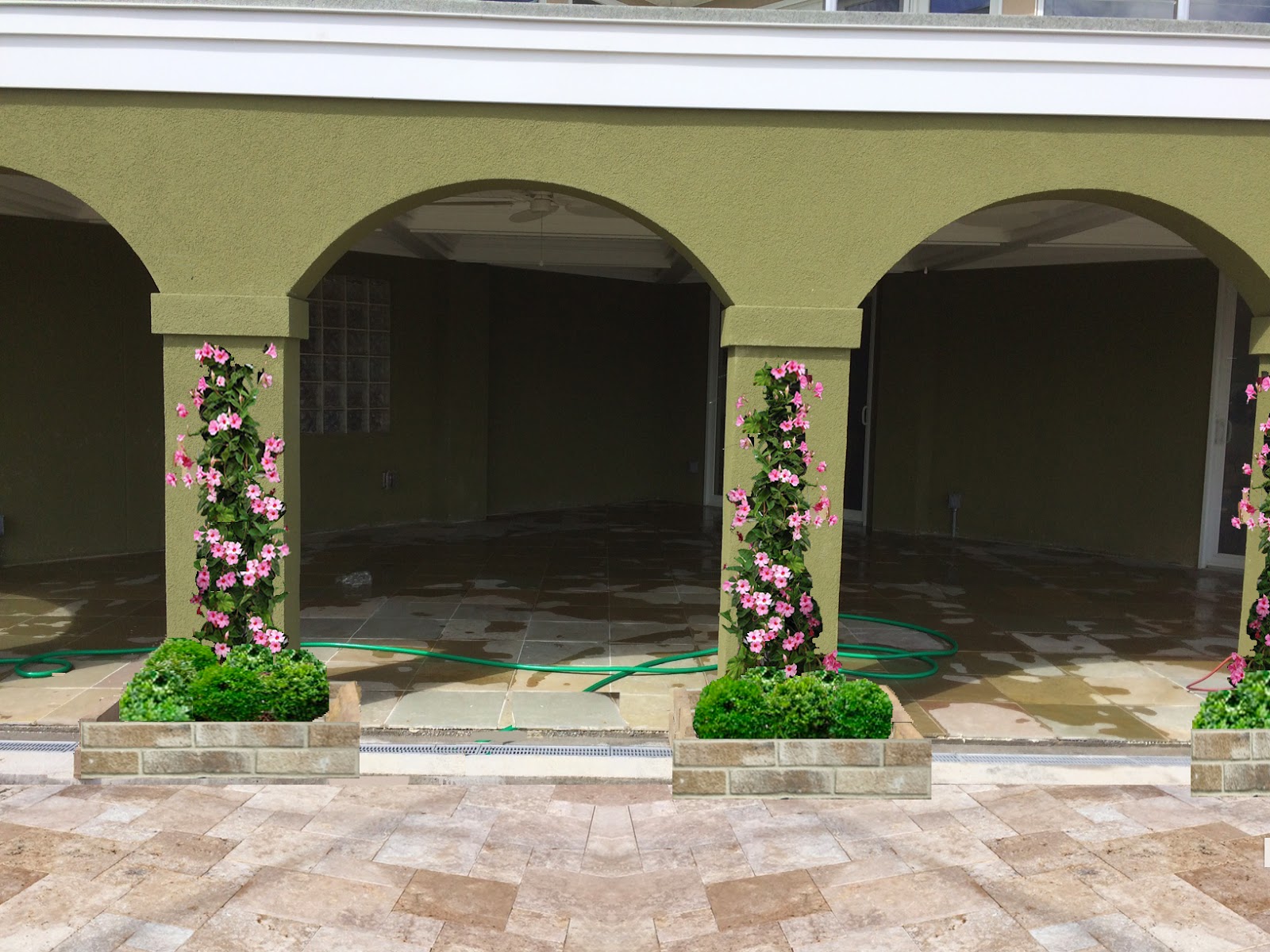
This is the artist Jean Galle's rendering that was part of the client presentation. My garden design drawings spring to life with Jean's talent -- allowing the client to readily see the change and design.
Here, the design was to create a series of Pillar Potting Beds
* Five, 3 different sized beds - allowing for egress, conform to pillar and arch metrics and location
* Drainage to channel drain
* Center bed 30 x 24 x 8
* 2 side beds - 30 x 16 x 8 - flush w pillars
* 2 corner beds - angled

This is the actual first planting in the new Pillar Planter Beds!
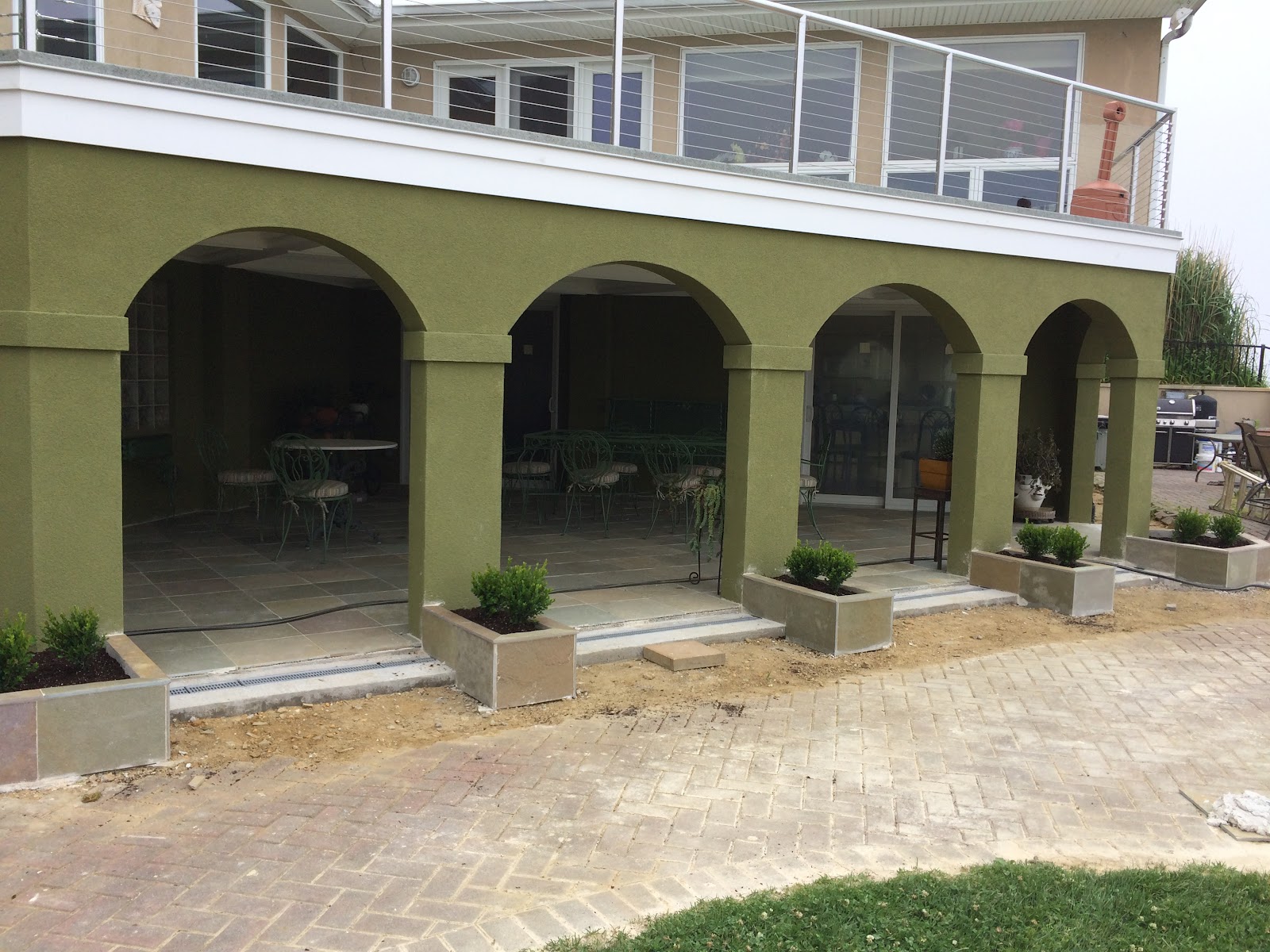
So exciting -- getting there!
Next up was the mason -- our wonderful Irish national mason, Aiden. I had them put in a sleeve for the irrigation hook up later, along with drains in the side window border garden. I asked previous mason, a great Mexican American, who also worked at our home, to put in drainage from the Pillar Planters out to the french drain in the lawn, some distance away. Grading and drainage is key here. The gardens front the bay and the view of the Manhattan skyline beyond.
Before-ish image of patio. Already, the top deck has been removed here. A blank slate.
Here is the interim -- arches are in, stucco going on.
I pick up from here with garden design - here are the before and afters.
This is the artist Jean Galle's rendering that was part of the client presentation. My garden design drawings spring to life with Jean's talent -- allowing the client to readily see the change and design.
Here, the design was to create a series of Pillar Potting Beds
* Five, 3 different sized beds - allowing for egress, conform to pillar and arch metrics and location
* Drainage to channel drain
* Center bed 30 x 24 x 8
* 2 side beds - 30 x 16 x 8 - flush w pillars
* 2 corner beds - angled
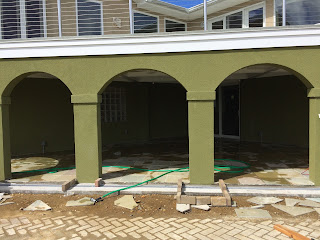 |
| Here and below - you see how we laid out the Pillar Planters for size & scale |
This is the actual first planting in the new Pillar Planter Beds!
So exciting -- getting there!
Next up was the mason -- our wonderful Irish national mason, Aiden. I had them put in a sleeve for the irrigation hook up later, along with drains in the side window border garden. I asked previous mason, a great Mexican American, who also worked at our home, to put in drainage from the Pillar Planters out to the french drain in the lawn, some distance away. Grading and drainage is key here. The gardens front the bay and the view of the Manhattan skyline beyond.
Sandy beat up this area rather badly… Recovery continues in stages...

Window Garden
I wanted to design a 4-season garden that can be enjoyed as a winter garden and not block the view during the summer or warm-weather season. There should also be a plant show element - using perennials for not only low maintainance (even though the Duchess team does the horticultural fine gardening work we need to create a garden bed that doesn’t require fussy care.) That show part is garden entertainment -- something always in bloom -- lots of color and texture. Good bones.

This is the before. The pavers were removed to allow a garden bed. And like the High Line, not a deep garden bed.
This is the artist's rendering of mixed border to-be:
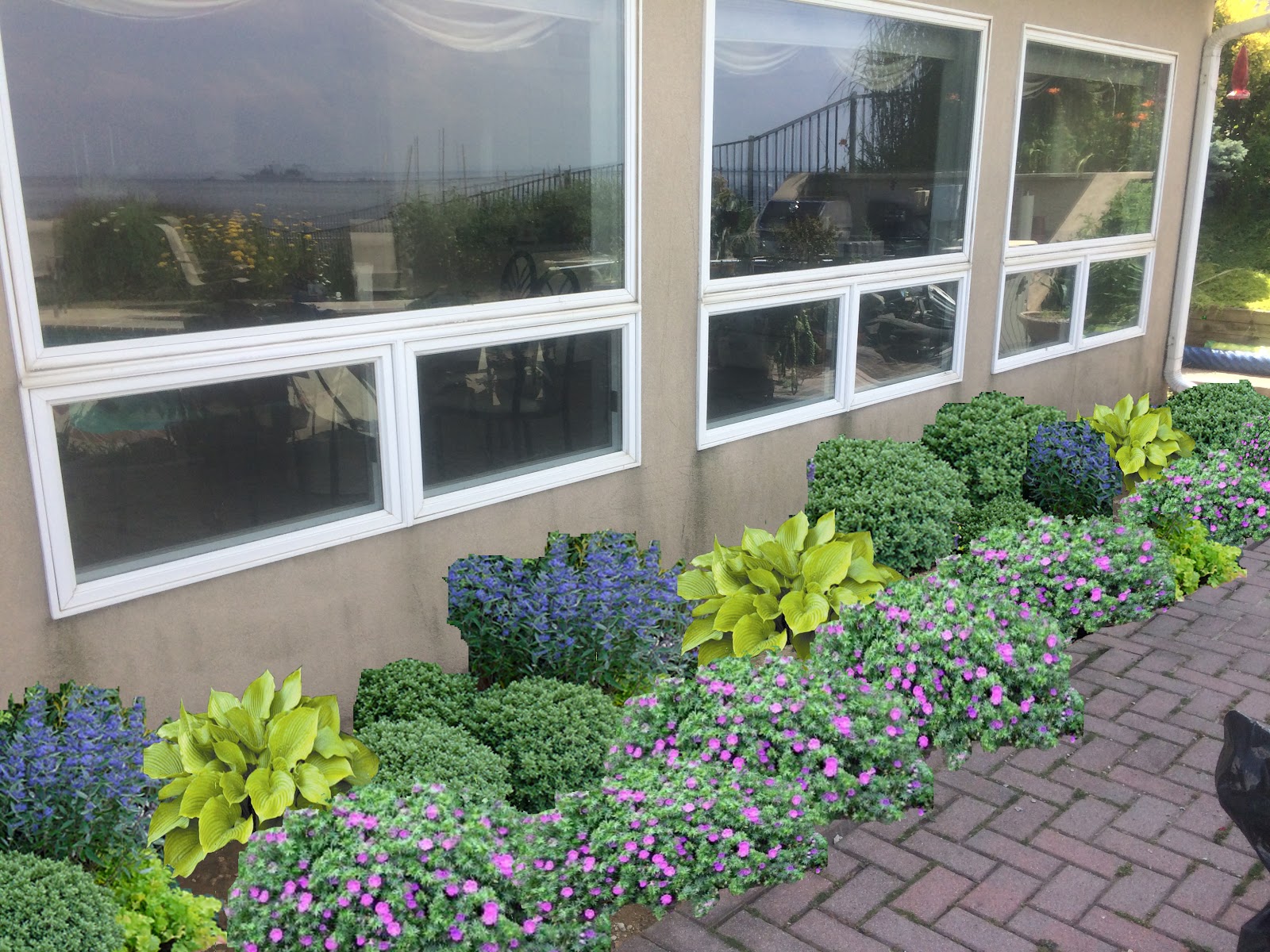

With the client’s approval - we got to work.
I went with Aiden the mason, to choose the border pavers. I wanted a textured top; nothing too expensive as the plants will swoon over the tops. The gray color will match the pool pavers that will be installed next year -- so thinking ahead.
Needed to take out the weeds and the “dirty” soil that was er, dumped in, following all the construction work. Duchess team put in topsoil blended with horse manure for a rich, bedding environment to welcome the new plants.
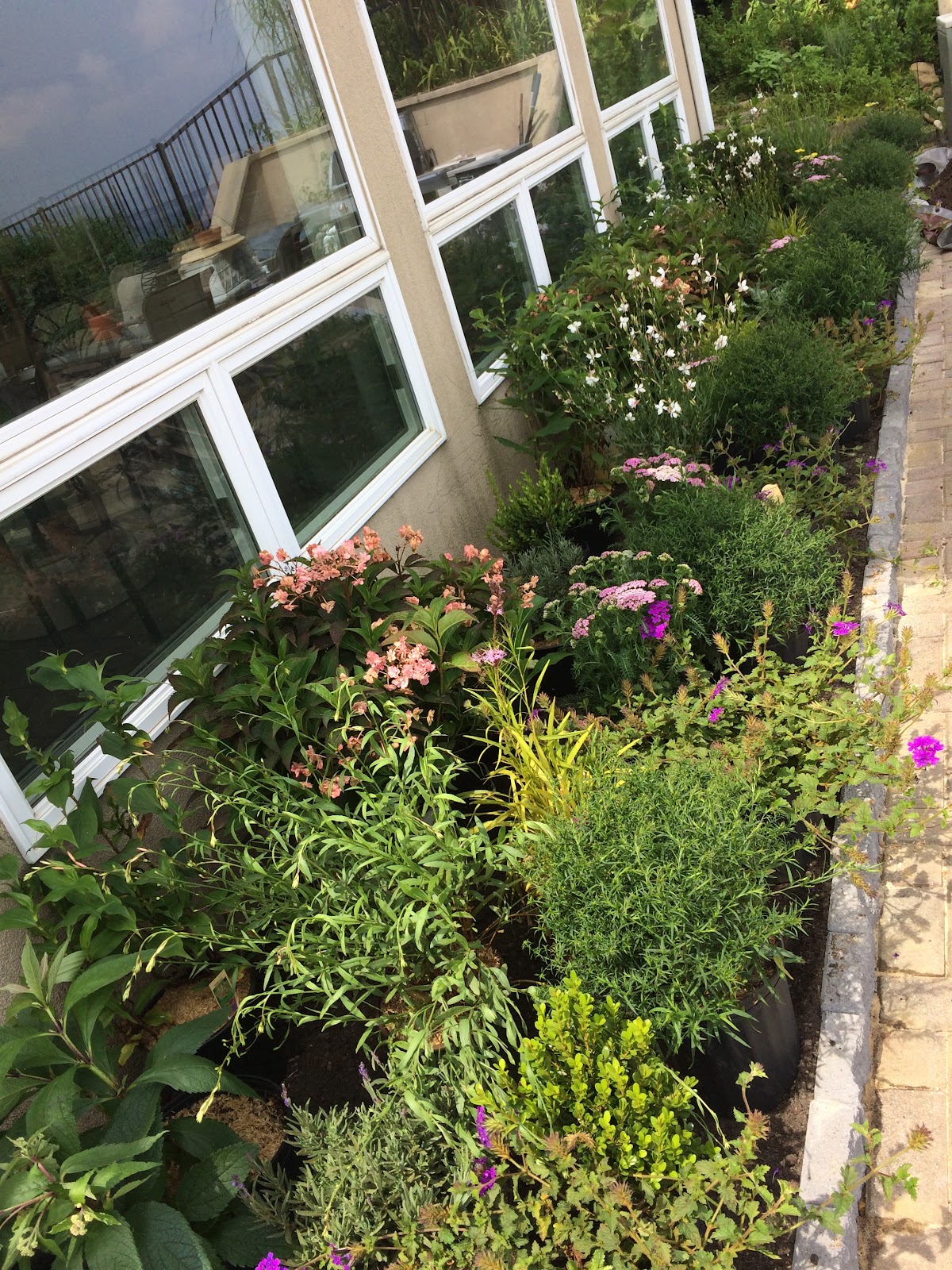
Exciting first shot of the new, English Garden bed!

As part of the Garden Design Presentation, offered a number of choices: edible, single plant or mixed border.


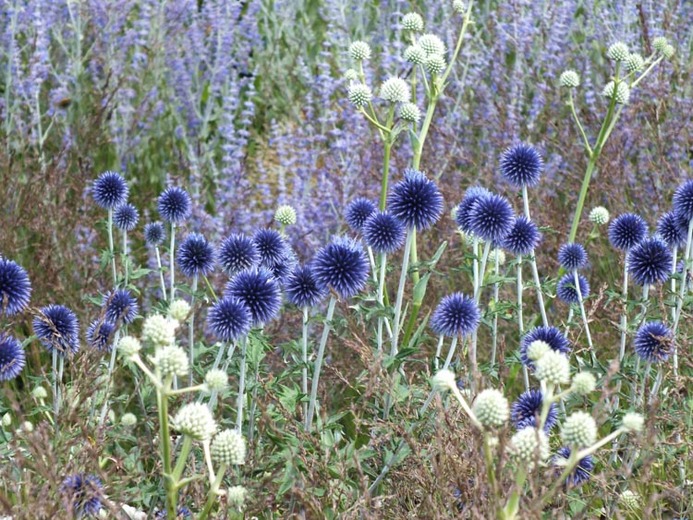
Boxwood provides good bones and evergreen look. Together, we decided a mixed border would offer the most bang and joy.
I also wanted plants that provided a pretty look from inside the kitchen windows -- almost a flat top looking down perspective.
Here’s the varied plant list that punched up the color and look and feel of the transitioning outdoor design.
Plant List:
Everyone was thrilled with the results.
Window Garden
I wanted to design a 4-season garden that can be enjoyed as a winter garden and not block the view during the summer or warm-weather season. There should also be a plant show element - using perennials for not only low maintainance (even though the Duchess team does the horticultural fine gardening work we need to create a garden bed that doesn’t require fussy care.) That show part is garden entertainment -- something always in bloom -- lots of color and texture. Good bones.
This is the before. The pavers were removed to allow a garden bed. And like the High Line, not a deep garden bed.
This is the artist's rendering of mixed border to-be:
With the client’s approval - we got to work.
I went with Aiden the mason, to choose the border pavers. I wanted a textured top; nothing too expensive as the plants will swoon over the tops. The gray color will match the pool pavers that will be installed next year -- so thinking ahead.
Needed to take out the weeds and the “dirty” soil that was er, dumped in, following all the construction work. Duchess team put in topsoil blended with horse manure for a rich, bedding environment to welcome the new plants.
Exciting first shot of the new, English Garden bed!
As part of the Garden Design Presentation, offered a number of choices: edible, single plant or mixed border.
Boxwood provides good bones and evergreen look. Together, we decided a mixed border would offer the most bang and joy.
I also wanted plants that provided a pretty look from inside the kitchen windows -- almost a flat top looking down perspective.
Here’s the varied plant list that punched up the color and look and feel of the transitioning outdoor design.
Plant List:
- Lavender ‘Hidcote Blue’ 12” x 12” summer
- Salvia ‘Marcus’ 8” purple
- Aster ‘Happy End’ 3” Pink autumn
- Achillea ‘Love Parade’ June - Sept. 18-23”
- Toad Lily Tricyrtis - 30” h x 12” w
- Gaura- ‘Stratosphere Pink Picotee’ 18-24” May - September
- Verbena ‘Homestead Purple’ 12-18”
- Eupatorium ‘Baby Joe’ 2-3’ purple - Autumn - I had to get this -- not only do I love it -- I have the big Joe in my border garden -- but the client’s name is Joe!
- Hydrangea serrata ‘Tiny Tuff Stuff’ 18-24” x 18” blue to pink - Love this size and color - even in the winter.
- Delphinium grandiflorum ‘Summer Blues’ 10-12” spring to summer
- Baptisia ‘Screaming Yellow’ - 2-3’ x 2’ spring/ early summer -- We planted these in the blueberry garden bed for texture and color contrast (love blue and yellow - so French).
- Liatris ‘Kobold’ 2’ x 12-15”
Everyone was thrilled with the results.
I just love when the client clasps their chest and repeats, “Oh my gosh. Oh my god!” Over and over. And then takes the time to text how beautiful it all looks and how the family is enjoying.
Such garden glamour...
Good garden design is hardscape, grading and drainage planning, careful selection of plants -- all with a recognition of lifestyle and personalities.
This is the start of a change in the use and look of the outdoor space. More summer projects to report on.
Good garden design is hardscape, grading and drainage planning, careful selection of plants -- all with a recognition of lifestyle and personalities.
This is the start of a change in the use and look of the outdoor space. More summer projects to report on.
What projects have you taken on this season?
If you want to make a change in your garden design -- after all, lifestyle changes occur so outdoor needs can grow from a child’s play area with lots of turf to one that boasts more of an outdoor living area with kitchen, sitting areas, and healthy edible gardens.
Tips for creating a garden room
Planting gardens and hardscape construction both require a professional. Whether you ultimately end up with a DIY project, it’s best to get a seasoned pro to offer ideas and design concepts and a suggested budget estimate. Yes, that will cost money - just like you pay an architect or an attorney or other professional for their talent; but at the same time you will benefit in terms of time and budget by bringing in outside counsel.
From there, you can retain the garden designer as a garden coach - helping lead you through the process but with you doing most of the work and labor involved in researching hardscapes and plant choices, shopping the nurseries and quarries, securing soil, mulch, pavers and more for the bones of the landscape space.
Did I mention irrigation and lighting?
And finally there is the installation of the plant material - by season, height, color, texture -- to garner maximum benefit. Knowing plant companions and interactions is knowledge accrued from experience and learning. I myself attend as many lectures and garden tours with horticulturists as my schedule allows. I bring that knowledge to my clients’ projects.
If you choose to have your garden designer carry through the project to completion, you can rely on their design and build expertise -- and follow up for the fine gardening maintenance that will need to be provided. Gardens are dynamic. They require care - even if low maintenance plants are selected. After all, they are living things! And there’s no denying it -- Gardens are an investment. Gardens and good landscape design (vs. “mow, blow, & go” lawn care) add to the value of a home with estimates ranging from a ten to 25% boost to a home’s cost.
And the intrinsic value is well -- priceless...
What luxury and enduring garden glamour….
If you want to make a change in your garden design -- after all, lifestyle changes occur so outdoor needs can grow from a child’s play area with lots of turf to one that boasts more of an outdoor living area with kitchen, sitting areas, and healthy edible gardens.
Tips for creating a garden room
Planting gardens and hardscape construction both require a professional. Whether you ultimately end up with a DIY project, it’s best to get a seasoned pro to offer ideas and design concepts and a suggested budget estimate. Yes, that will cost money - just like you pay an architect or an attorney or other professional for their talent; but at the same time you will benefit in terms of time and budget by bringing in outside counsel.
From there, you can retain the garden designer as a garden coach - helping lead you through the process but with you doing most of the work and labor involved in researching hardscapes and plant choices, shopping the nurseries and quarries, securing soil, mulch, pavers and more for the bones of the landscape space.
Did I mention irrigation and lighting?
And finally there is the installation of the plant material - by season, height, color, texture -- to garner maximum benefit. Knowing plant companions and interactions is knowledge accrued from experience and learning. I myself attend as many lectures and garden tours with horticulturists as my schedule allows. I bring that knowledge to my clients’ projects.
If you choose to have your garden designer carry through the project to completion, you can rely on their design and build expertise -- and follow up for the fine gardening maintenance that will need to be provided. Gardens are dynamic. They require care - even if low maintenance plants are selected. After all, they are living things! And there’s no denying it -- Gardens are an investment. Gardens and good landscape design (vs. “mow, blow, & go” lawn care) add to the value of a home with estimates ranging from a ten to 25% boost to a home’s cost.
And the intrinsic value is well -- priceless...
What luxury and enduring garden glamour….





















